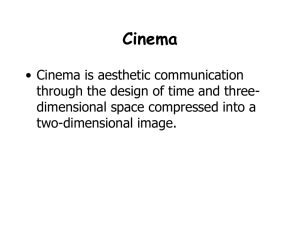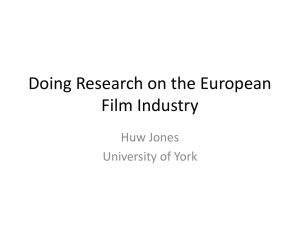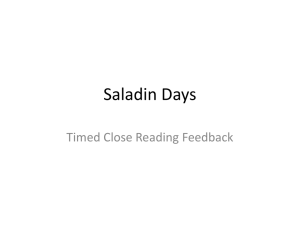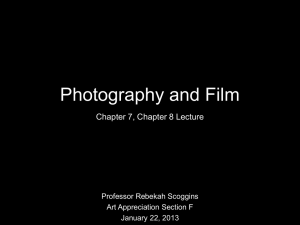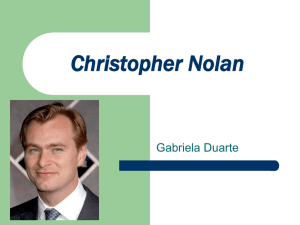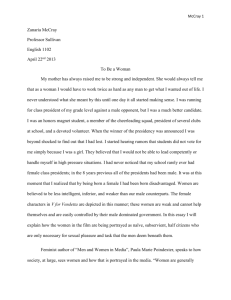V for Vendetta powerpoint
advertisement
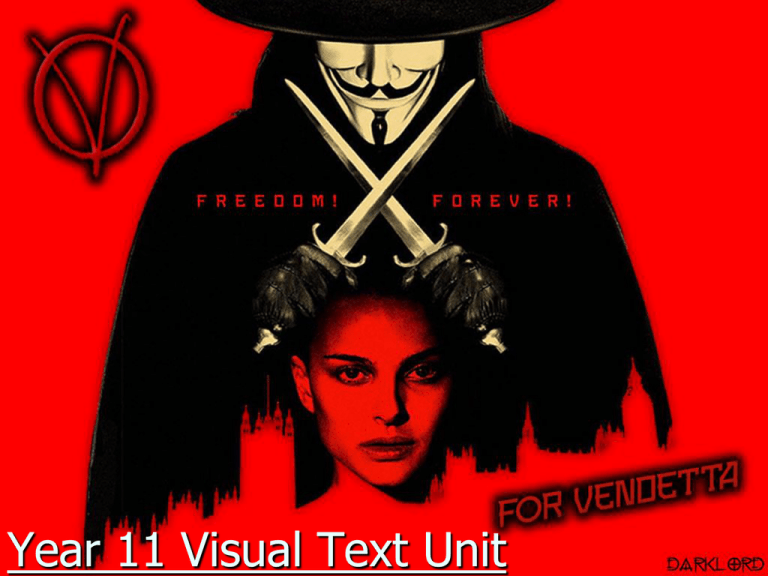
Year 11 Visual Text Unit Aims of Unit: After this unit I will: Understand key film terminology Become familiar with camera angles and shots and their intended effects Study the aspects of film (lighting, sound, costume, makeup, characters, theme, setting, special fx, camera) View and take notes on a selected film Write several essays on aspects of the film Studying a film You can use the same text features as written texts, characters, setting, theme, etc. But a films quality is also dependent on its technical features. It is required that you comment on these in your essays. The atmosphere in film is created by sound effects, music and camera work. The camera (rather than narrative or dialogue) is the main way the audience attention is drawn to what is important. The Literary features of Film PLOT CHARACTERS FILM SETTIN G THEMES PLOT should build up to a climax which is the highest point of tension in the film and usually occurs at or near the end. Situation conflict crisis point resolution SUBPLOT Sometimes there is a subplot which runs side by side to the main plot. Sub plots add depth and complexity to a story as well as emphasising some of the main ideas. Acts Most films have 3 acts. The first act is about 17 minutes long and ends with a crucial turning point which leads into act 2. This is known as the page 17 moment. This is the moment of no return for the protagonist. This is usually a conscious decision by the director. 16-18 minutes At this point the protagonist has no control over their life. In the second turning point, they do have control or they take control. This leads into the final act. The Grammar of Film A story consists of letters Which make up words Words make up sentences Sentences make up paragraphs Paragraphs make up a story A film consists of frames Frames make up shots Shots make up scenes Scenes make up sequences Sequences make up a film Themes in film Most films have an important message. This may be a comment on society, on human relationships or values or the film may have a moral. Some films help the viewer to understand others. Other films present groups of people as stereotypes. Setting Films usually establish a setting early on with establishing long shots quickly giving the audience a clear idea of the location. Once these have been established, the events and characters should appear both realistic and convincing as a part of this setting. Aspects of Setting Time - when Place - where Social Climate – gender roles - what was society like? - traditions, beliefs - economic state - political/religious state Setting is conveyed on film through vehicles, clothes, hairstyles, dialogue, music, songs, building styles, furniture, props and all other things that belong to a time and place. Characters In film, it is important for the actors to become the characters they are playing. You can judge these characters on 3 levels script, performance, direction(shots and what the director has told them to do) Only the second one is in the control of the actor. What to look for? How do they change? What do other characters think of them? What they say? What others say to them? Their relationships, conflicts, decisions. Their role in the film. What we can learn from them. What theme do they highlight? Appearance, background, talents? Technical aspects of film Costume makeup Mis en scene lighting Technical Features Camera shots Special Effects Sound & music Facts about V 4 V Based on Alan Moore’s graphic novel. Set after a limited nuclear war which has left much of the world destroyed. Fascist party is called Norsefire and they are the ruling power. First episodes were published in black and white between 1982-85 Premiere was supposed to be on Guy Fawkes night, 400th anniversary of the gunpowder plot. London bombings postponed it to March 2006. Director was James McTeigue – born in Tauranga. He directed the Matrix The original graphic novel is much darker than the film and was created as a response to British Thatcherism in the early 80’s (Margaret Thatcher). Running time 132 minutes Budget $54 million Moore disassociated himself from the film due to a continuous series of disagreements over film adaptions of his work. He did not want his name to appear in the closing credits. The illustrator of the graphic novel David Lloyd supported the films adaptation. V for Vendetta was filmed in London and Germany. Most of it was filmed on sound stages and indoor sets. The cinematographer Adrian Biddle died of a heart attack in Dec 05, making V his last film. The film was shot to have a future retro look, with a heavy use of grey tones to give a dreary, stagnant feel to London. The largest set for the film was the shadow gallery which was made to look like a crypt. This is V’s home and the place he stores a lot of forbidden artifacts from the government. E.g The lady of Shallot by John William Waterhouse. One of the biggest challenges of the film was bringing the character of V to life despite never seeing him or his expressions. Lighting, sound, and voice was used together to create the proper mood. A microphone was placed in his hairline and then to prevent muffling from the mask, his entire dialogue was re recorded post filming. James Purefoy was originally cast for V but he couldn’t handle wearing the mask for long periods of time. Questions?? What was the name of the girl imprisoned next to V? What was the movie she was well known for? What is the Chancellor’s name? Each of the law enforcement structures take their name from parts of ? How old was Evey when her parents were detained? Who deactivated the bomb set by V? How did Evey know the anchor woman was lying about Prothero’s death? How did Evey’s brother die? What is Gordon’s secret? Evey appeared in what Shakespeare play as a child? Who does Evey go out after curfew to visit? What is the famous poem that Evey and V recite? When Evey comes back to see V on the eve of November 5, what does he ask her to do? What type of flower did V leave with his victims? What is the slogan on the sign V slices into? What is the last thing Evey says to V? What is Evey’s last name? What is the first building that is destroyed by V? Who plays the character V? Evey? What did V call his home? What did V endure years ago? Who lived at 6 Albery Street? What does the guard say to Evey when she refuses to answer their interrogation when she is captured? Why can she go from her cell? Why did V torture her? Is V a freedom fighter or a terrorist? Do you think Evey and V love each other in the end? Who sympathises with V? What has happened to the rest of the world outside Britain? Stephen ? And Stephen ? Who plays the role of the Chancellor? What is the piece of classical music that V uses? Where does Evey work? Why does Evey escape from V? Why does Gordon’s home get searched? What is so significant about Evey getting her head shaved? What is the Inspectors name? Britain has previously suffered from war and terrorism due to their assistance in the ? Norsefire has to restore order so enemies of the state ?? This caused the country to be deeply ? A ? occurred which killed over ? People A cure for the virus was distributed which made Norsefire a huge amount of money. This mean that they could ? all opposition and ? the next election by a landslide. The attack has been engineered by ? to gain power of the people. Who were the people detained at the Larkhill Detention Centre? What was special about V? Why is he called V? What does V ship out to hundreds of homes? What is so important about these masks? The wearing of these masks encourages some of the citizens to do ? Why does V go to meet the Chanceller and Creedy? Why does V survive the barrage of bullets? How does he kill Creedy? Who kills the Chancellor? Why does Inspector Finch let Evey carry on and blow up parliament? Who is V? Using the Camera To make a good film, you must understand the language of film making. How to use a camera, compose a sequence of shots, control lighting, change the depth of field and edit to produce a quality finished product. Technical Terms Subject: The person or thing being filmed. Aperture: the size of the opening of the lens which controls the amount of light reaching the film. Each time the camera stops and starts again, a new shot begins. Each attempt at a shot is called a take. Depth of field means the amount of the view through the camera which is the focus. The flow of shots which deal with the same subject in order is called a sequence. Sequences which run together produce a scene. A frame is a single picture on celluloid or magnetic film. The Camera Movement Special Purpose shots Shots Camera Angles Focus Speed Angles High Angle – Camera is higher than subject and looks down so the subject appears to be small, weak or threatened. Level Angle – Usual level for filming. Camera is at subject’s eye level. Low Angle – Looking up at subject who now appears to be tall and powerful. Shots The main shots you need to learn are; Close up Extreme close up Long shot / establishing shot Medium / mid shot Reaction shot Over the shoulder shot Crane shot Hand held camera Movement Walking with a hand held camera will produce an unsteady picture, as if the viewer is in the scene and are the eyes of the subject. Using a tripod enables a steady picture. Static – The subject remains in the same position, so the camera does not need to move at all. Zoom – Requires a zoom lens. The subject can be made larger or smaller without moving the subject or object. Pan – Swivelling a mounted camera from side to side. Tilt – Tilting the camera vertically up and down. Head on – The subject moves towards the camera and involves the audience. Tail away – The subject walks away from the camera. Tracking – Requires some sort of mobile support called a dolly to wheel the camera along as it follows the subject. Pull back – The camera moves back from an object first seen in a close up to a place in context. This shot usually suprises the viewer. Special Purpose Shots Cut-away – a very brief shot of something connected with the scene but outside the action. Usually some clouds or scenery. Cut-in or insert – a very brief shot of something involved with the action. Re establishing shot – Usually a long shot which shows the audience the whole scene again. Focus Focusing on close objects or subjects keeps our attention while other objects or the background seems blurred. An impression of depth is given by changing the focus or arranging objects in the scene to show distance. Focus is not just about getting the subject clear. Most shots of a nearby subject look best if the background is blurred. The smaller the lens opening (aperture) the greater the depth of field. When you narrow the depth aperture to increase the depth of field, you cut down the amount of light which reaches the film.To make up for this, you need to increase the amount of light available as you reduce the size of the aperture so that the subject remains clearly visible. Speed Many cameras have adjustable film speed. Speeded up shots are created by slowing the film down. Fast motion is often used for humour or is sometimes effective as a means of compressing time. Slow motion is used to focus attention on an action or emotion. Tchaikovsky’s 1812 Overture was written to commemorate Russia’s 1812 defense against Napolean’s advancing Grande Armee at the Battle of Norodino during the French invasion of Russia. The Overture debuted in the cathedral of Christ the Saviour in Moscow on August 20, 1882. It is best known for its climactic volley of cannon fire and ringing chimes. It is used often in the US for celebrations like Independence Day. What happened? On September 7, 1812 (75 miles) west of Moscow at Borodino, Napolean’s forces met those of Mikhail Illarionovich Kutuzov from Russia. The French Army was known to be invincible. The battle saw casualties as high as 100,000 and produced victory for neither side. It did however break the back of the French invasion. The Russian army retreated and Napolean’s forces moved into Moscow but had no food, froze, endured famine etc. The Russian forces barred their way out of the country. Napolean abandoned them and the army was one tenth its original size by the time it reached Poland. Sixteen cannon shots are written into the musical score, each one combined with a mixture of notes and playing of “God preserve thy people” portraying the increasing distress of the Russian people at the hands of the invading French. At the turning point of the invasion, the score calls for five Russian cannon shots. The descending string passage represents the subsequent attrition of the French forces, followed by the victory bells and triumphant repetition of “God preserve thy people”. A musical chase appears, out of which emerges the anthem “God Save the Tsar!” thundering with eleven more precisely scored shots. VOILA "Voilà! In view, a humble vaudevillian veteran, cast vicariously as both victim and villain by the vicissitudes of Fate. This visage, no mere veneer of vanity, is it vestige of the vox populi, now vacant, vanished, as the once vital voice of the verisimilitude now venerates what they once vilified. However, this valorous visitation of a bygone vexation stands vivified, and has vowed to vanquish these venal and virulent vermin vanguarding vice and vouchsafing the violently vicious and voracious violation of volition. The only verdict is vengeance; a vendetta held as a votive, not in vain, for the value and veracity of such shall one day vindicate the vigilant and the virtuous. Verily, this vichyssoise of verbiage veers most verbose vis-à-vis an introduction, and so it is my very good honor to meet you and you may call me V." Sound Music should be suitable for the setting and mood of the film. It is used to support the dramatic sequences by inspiring tension and expectations in the right places. Sound effects add to the realism of the film. Sound Terms Ambient: ‘live’ background sounds creating the illusion that we are seeing and hearing a real world such as the sounds of distant birds or cars. Wild (live) sound: sound actually recorded while the shot is made, e.g footsteps, clapping, birds chirping. Background music: Off screen, non diegetic sound. The music does not originate from within the action but accompanies it to heighten the emotional intensity or drama. Dubbing: Replaces sounds, voices or languages on the sound track with others, though maintaining their sync with the image as much as possible. Sound effects: Mixed into the sound track to accompany action as if they were already there. Diegetic??? Diegetic sound: Source of the sound is visible on the screen or implied to be present by the action. e.g voices of characters, objects in the story, music coming from instruments Another word for digetic sound is ‘actual’ sound. It comes from the greek word diegesis meaning ‘recounted story’. Non diegetic?? Sound whose source is neither visible on the screen nor has been implied to be present. e.g narrator’s commentary Sound effects added for dramatic effect Mood music Mise en scene An expression used in theatre and film to describe the design aspects of a production. The french term literally means “putting on stage”. This refers to everything that appears before the camera and its arrangement. Guy Fawkes 15 April 1570 - 31 January 1606 Sometimes known as Guido Fawkes Was a member of a group of Catholic revolutionaries from England. Robert Catesby actually thought up the gunpowder plot but Fawkes was put in charge of executing it because of his experience. Fawkes was caught guarding the explosives as he was wearing a coat, boots and spurs. This is of course what V wears. The English parliament repressed local Catholics. One example was a lady called Margaret Clitherow who protected Catholic priests in her home and as a result was crushed to death. England was divided between Protestants and Catholics. Fawkes spent 10 years fighting for the Spanish Catholic cause as a soldier. He gained a lot of experience with explosives during this time. The plot was to kill King James 1 of England, his family and most of the aristocracy by blowing up the House of Lords in the Palace of Westminster during the State Opening of Parliament. When Fawkes was caught, he was asked by one of the Scottish Lords “What did you intend to do with so much gunpowder?” He answered, “To blow you Scotch beggars back to your own native mountains.” On 31 January 1606, Fawkes and a number of others were tried in Westminster Hall. After being found guilty, they were taken to the Old Palace Yard in Westminster and St Pauls Yard where they were hanged, drawn and quartered. Fawkes, however cheated the hangman by jumping from the scaffold, breaking his neck before he could be drawn and quartered.
